Archive for April, 2010
-
Terrific Thomson’s Gazelles
Posted in Wildlife A-Z | April 30, 2010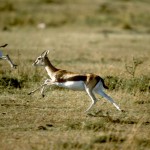 Gazelles belong to the antelope family. These medium-sized antelopes are found predominantly in Africa and Asia. Small numbers are found far east in Mongolia. There are 19 different species of gazelles. Gazelles are grazing antelopes and live in herds. The herd may include ten to hundred animals. They form large groups in the plentiful rainy season. These groups may contain thousands of gazelles. Wide-open spaces and plains serve as the grazing areas for these gazelles. They feast on grass, shoots, and leaves. Open plains make them vulnerable to predators such as cheetahs and wild dogs. However, gazelles can run very fast. These gazelles can reach speeds of 40 miles per hour. Some species of gazelles prefer the mountainous landscapes and deserts. [...]
Gazelles belong to the antelope family. These medium-sized antelopes are found predominantly in Africa and Asia. Small numbers are found far east in Mongolia. There are 19 different species of gazelles. Gazelles are grazing antelopes and live in herds. The herd may include ten to hundred animals. They form large groups in the plentiful rainy season. These groups may contain thousands of gazelles. Wide-open spaces and plains serve as the grazing areas for these gazelles. They feast on grass, shoots, and leaves. Open plains make them vulnerable to predators such as cheetahs and wild dogs. However, gazelles can run very fast. These gazelles can reach speeds of 40 miles per hour. Some species of gazelles prefer the mountainous landscapes and deserts. [...] -
Awesome American Alligator
Posted in Wildlife A-Z | April 28, 2010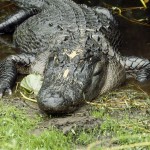 The American alligator is a rare story of success for an endangered animal to be saved from extinction. The numbers of the American alligator continue to thrive. The population has improved due to federal protection and habitat conservation efforts. The demand for alligator products has also reduced. The population is presently in excess of one million. These menacing predators have lizard-like bodies, muscular tails, and powerful jaws. They appear well armored. Research has put the alligator species at around 150 million years old. Their prehistoric partners included dinosaurs. They managed to avoid extinction some 65 million years ago. American alligator inhabit freshwater rivers, lakes, swamps, and marshes. They are found in large numbers [...]
The American alligator is a rare story of success for an endangered animal to be saved from extinction. The numbers of the American alligator continue to thrive. The population has improved due to federal protection and habitat conservation efforts. The demand for alligator products has also reduced. The population is presently in excess of one million. These menacing predators have lizard-like bodies, muscular tails, and powerful jaws. They appear well armored. Research has put the alligator species at around 150 million years old. Their prehistoric partners included dinosaurs. They managed to avoid extinction some 65 million years ago. American alligator inhabit freshwater rivers, lakes, swamps, and marshes. They are found in large numbers [...] -
Wonderful Wild Turkey
Posted in Europe | April 26, 2010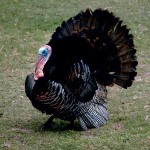 The turkey was pitted by Benjamin Franklin to be the national bird of the United States. This noble fowl is a favorite dish among Native Americans. With the arrival of the Europeans, the turkey was one of the two domestic birds that are native to America. The Muscovy duck is the other bird. By the early 20th century, wild turkey ceased to roam over their normal range. Hunting wiped out a large population of turkeys. Their woodland habitat is also in danger of disappearing. Wild turkeys primarily forage on forest floors. In addition, they can also be found in grasslands and swamps. They predominantly feed on nuts, seeds, fruits, insects, and salamanders. The 1940s saw the reintroduction programs for wild turkey. The birds were relocated to regions [...]
The turkey was pitted by Benjamin Franklin to be the national bird of the United States. This noble fowl is a favorite dish among Native Americans. With the arrival of the Europeans, the turkey was one of the two domestic birds that are native to America. The Muscovy duck is the other bird. By the early 20th century, wild turkey ceased to roam over their normal range. Hunting wiped out a large population of turkeys. Their woodland habitat is also in danger of disappearing. Wild turkeys primarily forage on forest floors. In addition, they can also be found in grasslands and swamps. They predominantly feed on nuts, seeds, fruits, insects, and salamanders. The 1940s saw the reintroduction programs for wild turkey. The birds were relocated to regions [...] -
Patient Praying Mantis
Posted in Wildlife A-Z | April 22, 2010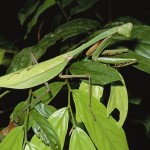 The praying mantis gets its name due to the prominent front legs. They are often bent and held at an angle, which suggests the position of prayer. The larger group of these insects is known as praying mantids. Mantis indicated the genus, mantis. Only a few praying mantids belong to these genus. Irrespective of the name, these insects are wonderful predators. Their head are triangular and situated on a long ‘neck’ or extended thorax. Mantids have the ability to turn their heads 180 degrees. They are able to scan their surroundings with the help of two large compound eyes. They are green or brown in color. They are well camouflaged on the plants on which they live. Mantids are known for their ambushes. They patiently stalk their prey. They [...]
The praying mantis gets its name due to the prominent front legs. They are often bent and held at an angle, which suggests the position of prayer. The larger group of these insects is known as praying mantids. Mantis indicated the genus, mantis. Only a few praying mantids belong to these genus. Irrespective of the name, these insects are wonderful predators. Their head are triangular and situated on a long ‘neck’ or extended thorax. Mantids have the ability to turn their heads 180 degrees. They are able to scan their surroundings with the help of two large compound eyes. They are green or brown in color. They are well camouflaged on the plants on which they live. Mantids are known for their ambushes. They patiently stalk their prey. They [...] -
Amazing Asian Elephant
Posted in Wildlife A-Z | April 21, 2010 The elephant is the world’s largest animal. The Asian elephant is slightly smaller than its African counterpart. The Asian elephant can be distinguished by their small, rounded ears. The ears of the African elephant resemble the contours of the African continent. To keep cool, ears of the elephant radiate heat. This is not always enough. Elephants love playing in water. They suck water with the help of their trunks and spray it all over their body. The elephant’s trunk is in reality a long nose and has many functions. Elephants use their trunk for smelling, breathing, drinking, grabbing things, and sounding the trumpet. The trunk contains nearly 100,000 diverse muscles. A finger-like feature at the end of the trunk is characteristic of Asian [...]
The elephant is the world’s largest animal. The Asian elephant is slightly smaller than its African counterpart. The Asian elephant can be distinguished by their small, rounded ears. The ears of the African elephant resemble the contours of the African continent. To keep cool, ears of the elephant radiate heat. This is not always enough. Elephants love playing in water. They suck water with the help of their trunks and spray it all over their body. The elephant’s trunk is in reality a long nose and has many functions. Elephants use their trunk for smelling, breathing, drinking, grabbing things, and sounding the trumpet. The trunk contains nearly 100,000 diverse muscles. A finger-like feature at the end of the trunk is characteristic of Asian [...] -
Majestic Monarch Butterflies
Posted in Wildlife A-Z | April 21, 2010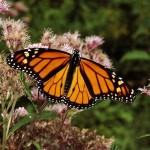 Monarch butterflies are renowned for their mass migration. This migration brings millions of them to California and Mexico every winter. North American Monarchs are the only species of butterflies that undertake such a massive journey, which includes more than 3000 miles. The winters are particularly harsh; therefore, they need to make this journey every autumn. Monarch butterflies start life’s journey as eggs. They then hatch as larvae and eat their eggshells. They then feed on milkweed plants. These butterflies are wholly dependent on milkweed plants. Over the course of time, fattening larvae become juicy and colorful caterpillars. While they enter the pupa stage, they form a hard protective case around themselves. Their primary colors [...]
Monarch butterflies are renowned for their mass migration. This migration brings millions of them to California and Mexico every winter. North American Monarchs are the only species of butterflies that undertake such a massive journey, which includes more than 3000 miles. The winters are particularly harsh; therefore, they need to make this journey every autumn. Monarch butterflies start life’s journey as eggs. They then hatch as larvae and eat their eggshells. They then feed on milkweed plants. These butterflies are wholly dependent on milkweed plants. Over the course of time, fattening larvae become juicy and colorful caterpillars. While they enter the pupa stage, they form a hard protective case around themselves. Their primary colors [...] -
Tremendous Toucan
Posted in Wildlife A-Z | April 20, 2010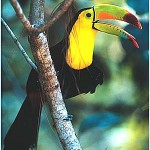 South America’s tropical forests are home to the Toco toucan. These beautiful birds are recognized everywhere. The oversized, colorful bill is characteristic of the bird. This has ensured that the toucan is one of the world’s most popular birds. The bill extends for 7.5 inches. It can be viewed as a mating trait; however, both male and female toucans possess these bills. Both, males and females use their bills to obtain tasty morsels of food. They pitch this food to one another during a fruit toss, which is characteristic of a mating ritual. When it comes to weaponry, the bill is more of a showcase item and does pack much substance. It is a honeycomb of bone and contains a lot of air. The size of the bill may prove a deterrent for predators. [...]
South America’s tropical forests are home to the Toco toucan. These beautiful birds are recognized everywhere. The oversized, colorful bill is characteristic of the bird. This has ensured that the toucan is one of the world’s most popular birds. The bill extends for 7.5 inches. It can be viewed as a mating trait; however, both male and female toucans possess these bills. Both, males and females use their bills to obtain tasty morsels of food. They pitch this food to one another during a fruit toss, which is characteristic of a mating ritual. When it comes to weaponry, the bill is more of a showcase item and does pack much substance. It is a honeycomb of bone and contains a lot of air. The size of the bill may prove a deterrent for predators. [...] -
Big Bend National Park
Posted in North America | April 20, 2010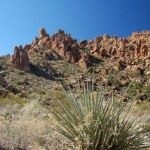 Big Bend National Park is located in Texas (Brewstar County) in the United States. The park authority administers almost 400 km area along the US-Mexico boundary formed by Rio Grande / Río Bravo. Big Bend National Park is the largest protected area of Chihuahuan Desert topography and ecology in the United States spread over an area of 3,242 square kilometres. The park was founded in 1944. The park is administered by National Park Service. The park has been named Big Bend after the huge left-turn made by river Rio Grande that meanders its way through the Texas desert. Geography: Big Bend National Park has three distinct geographical features, namely, desert, mountain, and river. Emory Peak is the highest point at 2,387 metres. Climate: Big [...]
Big Bend National Park is located in Texas (Brewstar County) in the United States. The park authority administers almost 400 km area along the US-Mexico boundary formed by Rio Grande / Río Bravo. Big Bend National Park is the largest protected area of Chihuahuan Desert topography and ecology in the United States spread over an area of 3,242 square kilometres. The park was founded in 1944. The park is administered by National Park Service. The park has been named Big Bend after the huge left-turn made by river Rio Grande that meanders its way through the Texas desert. Geography: Big Bend National Park has three distinct geographical features, namely, desert, mountain, and river. Emory Peak is the highest point at 2,387 metres. Climate: Big [...] -
Hawaii Volcanoes National Park
Posted in North America | April 19, 2010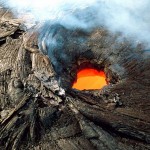 Hawaii Volcanoes National Park is located on Big Island off the island of Hawaii in the USA. The park, established in 1916, has a long natural evolutionary history. Hawaii Volcanoes National Park has been designated as an International Biosphere Reserve in 1980 and a World Heritage Site in 1987. The area of the park is 1,309 square kilometres. The park is governed by National Park Service. Hilo is the nearest city. Geography: The park has a great geographical variety ranging from sea to massive volcano (The largest volcano in the world, Mauna Loa with an altitude of 4,169 metres is located here). The landscape features range from volcanic lavas, dry forest to rainforest and rocky beaches. Volcanic manifestations include calderas, pit craters, [...]
Hawaii Volcanoes National Park is located on Big Island off the island of Hawaii in the USA. The park, established in 1916, has a long natural evolutionary history. Hawaii Volcanoes National Park has been designated as an International Biosphere Reserve in 1980 and a World Heritage Site in 1987. The area of the park is 1,309 square kilometres. The park is governed by National Park Service. Hilo is the nearest city. Geography: The park has a great geographical variety ranging from sea to massive volcano (The largest volcano in the world, Mauna Loa with an altitude of 4,169 metres is located here). The landscape features range from volcanic lavas, dry forest to rainforest and rocky beaches. Volcanic manifestations include calderas, pit craters, [...] -
Arches National Park Utah
Posted in North America | April 19, 2010 Arches National Park is an American national park located in Canyon Country in the eastern part of the state of Utah in the United States. The Arches National Park Utah is famous for the world’s biggest concentration of natural sandstone arches (about 2,000 of them), including the famous Delicate Arch and other fascinating geological formations. The park is 310 square kilometres in size with the highest elevation being Elephant Butte (1,723 metres). Forty three arches have crumbled under erosion since 1970. The park was designated as a National Monument in April 1929 and a national park in November 1971. The park is administered by National Park Service. Climate: Temperature frequently varies in Arches National Park Utah. July is the hottest [...]
Arches National Park is an American national park located in Canyon Country in the eastern part of the state of Utah in the United States. The Arches National Park Utah is famous for the world’s biggest concentration of natural sandstone arches (about 2,000 of them), including the famous Delicate Arch and other fascinating geological formations. The park is 310 square kilometres in size with the highest elevation being Elephant Butte (1,723 metres). Forty three arches have crumbled under erosion since 1970. The park was designated as a National Monument in April 1929 and a national park in November 1971. The park is administered by National Park Service. Climate: Temperature frequently varies in Arches National Park Utah. July is the hottest [...]


